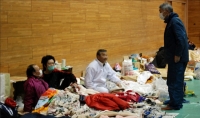Fukushima evacuees failed by information flow
12 June 2012
Breakdowns in communication caused extra confusion and contributed to the distress of residents evacuated from their homes following the Fukushima Daiichi nuclear accident, a survey carried out for the Japanese Diet has revealed.
 |
| Evacuees at a Fukushima high school in March 2011 (Image: VOA/S Herman) |
In the survey, a group of 21,000 of the 55,000 households in twelve towns, cities and villages in the evacuation zones was randomly selected to receive the postal survey. Just over 50% - 10,633 households - responded. About three-quarters of the respondents also provided comments, some of them extensive, indicating the strength of feeling amongst those surveyed, according to the Fukushima Nuclear Accident Independent Investigation Committee (NAIIC).
The committee was set up by the Diet in December 2011 and is tasked with investigating the background and causes of the Fukushima accident and proposing measures both to prevent and to reduce the effects of any future accidents.
The survey - conducted between 15 March and 11 April 2012, just after the first anniversary of the accident - found that governmental delays in transmitting and communicating information contributed to confusion for evacuees. Delays in passing on information meant that awareness of the accident was initially extremely low amongst residents, with significant differences in the speed at which information reached different areas depending on proximity to the plant.
Those municipalities that received governmental evacuation orders were able to pass on those orders to residents within hours of receiving them, but some municipalities that needed to evacuate did not receive orders from the government. Some residents received orders to evacuate but no contextual information that would have been useful to them, meaning that they fled with only the barest necessities.
In a region suffering the after-effects of a major earthquake and tsunami, some of the comments reported by NAIIC show residents did not realise they were being evacuated from their homes because of a nuclear accident and might not be able to return for a long time. Many reported fleeing in just the clothes they were wearing, without taking time to gather valuables, medical records or even to lock their homes, with some thinking they were being evacuated because of the risk of a further tsunami.
Tepco pays voluntary leavers
Tepco has announced its compensation payouts for so-called voluntary refugees from the Southern Fukushima prefecture. Voluntary evacuation is defined as evacuation not instructed by the government. Permanent residents of Southern Fukushima who were aged 18 or younger or were pregnant at the time of the accident are entitled to receive compensation of ¥200,000 (just over $2500) per person for the period 11 March-31 December 2011.
The compensation payments are to cover increased living expenses due to evacuation, emotional distress caused by the disruption of daily life, and the costs of transportation both for evacuation and for returning home. For those who chose to stay in the prefecture, the payments cover "emotional distress caused by the fear or anxiety for radiation exposure" and restricted freedom causing disruptions to daily life and increases in living expenses caused by such fears and restrictions.
In the hours following the start of the emergency, evacuation orders were issued firstly for a zone close to the plant with residents living 3-10 km from the plant advised to stay indoors. The next day the evacuation zone was increased to 10 km, then 20 km, and finally the government requested voluntary evacuation for residents 20-30 km from the plant on 25 March, two weeks after the accident began.
Most residents in the zones closest to the stricken plant had started to evacuate within hours of evacuation orders being issued, the survey found. However, in the 30 km zone where evacuation orders were issued "late or ... not issued at all", residents had to make the decision to evacuate for themselves.
The government's failure to issue timely evacuation orders came in for widespread criticism amongst the survey's respondents. A lack of accurate information was also widely cited in comments. Many referred to TV reports before the evacuations were ordered, which offered reassurance that the accident posed no immediate health effects without giving information on the accident itself or likely developments.
This has also apparently had a knock-on effect with evacuees now unwilling to trust more recent news that some evacuation zones can now be lifted. "Where there is very little progress in decontamination, it is too strange that the evacuation order has been lifted already," said one, while another respondent remained convinced that lifting evacuation orders was a government attempt to cover up radiation exposures received before the evacuations took place.
Not SPEEDI
The failure to disclose information from Japan's already established System for Prediction of Environmental Emergency Dose Information (SPEEDI) also came in for criticism. Many evacuees moved to areas which were then subsequently included in the widening evacuation zones, with most having to move on at least four times after their initial evacuation order and some facing six or more relocations.
The survey also revealed a lack of education or preparation for a nuclear accident among the population prior to 11 March 2011. Even in the areas closest to the Fukushima Daiichi plant, only 10-15% of residents reported having received evacuation training prior to the accident, while less than 10% said they had ever been informed that such a situation could possibly occur. Residents' comments highlighted that they had frequently been assured of the safety and security of nuclear power, and thought that an accident could never occur.
Researched and written
by World Nuclear News